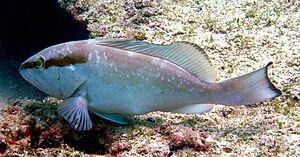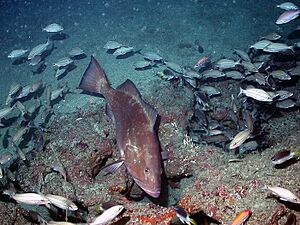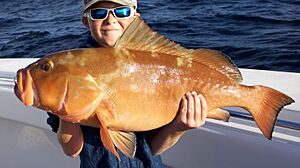Red grouper facts for kids
Quick facts for kids Red grouper |
|
|---|---|
 |
|
| Conservation status | |
| Scientific classification | |
| Synonyms | |
|
The red grouper (Epinephelus morio) is a type of fish that lives in the ocean. It belongs to a group of fish called groupers. These fish are part of a larger family that includes sea basses. You can find red groupers in the western part of the Atlantic Ocean.
Contents
What Does a Red Grouper Look Like?
The red grouper has a body that is about 2.6 to 3 times longer than it is deep. Its head has a straight upper edge on the gill cover. This cover has three flat spines, with the middle one being the longest.
The fish has two main fins on its back and belly. The top fin, called the dorsal fin, has 11 stiff spines and 16 or 17 soft rays. The bottom fin, called the anal fin, has 3 spines and 8 soft rays. Its front fins, the pectoral fins, are longer than its belly fins, the pelvic fins. The tail fin is flat at the end.
Red groupers are dark reddish-brown on their heads and backs. Their undersides are a lighter pink color. They have lighter spots and blotches all over their bodies. The edges of their fins are also darker.
These fish can grow up to 125 cm (about 49 inches) long. However, they are usually found around 50 cm (about 20 inches) long. The heaviest red grouper ever recorded weighed about 23 kg (about 50 lbs).
Where Do Red Groupers Live?
Red groupers typically live in coastal areas of the western Atlantic Ocean. Their home range stretches from southern Brazil all the way up to North Carolina in the United States. They also live in the Gulf of Mexico and near Bermuda.
Red Grouper Habitat and Life
Red groupers are fish that mostly stay on the ocean floor. They are not very active swimmers. When they are very young, they float in the open ocean for about 40 days. After this, they settle down in shallow coastal areas with hard bottoms.
Young groupers stay in these shallow waters for about 4 to 5 years. Then, as adults, they move to deeper offshore areas. They especially like the edges of the continental shelf. Red groupers usually lay their eggs offshore between January and June, with May being the busiest time.
What Do Red Groupers Eat?
Red groupers are always looking for food in their reef homes. They mainly eat small animals that live on the ocean floor. Their diet often includes different types of crabs, young spiny lobsters, and snapping shrimp. Sometimes, they will also eat other small fish.
Amazing Color Changes
Red groupers are usually reddish-brown with many white spots. But they can change their colors very quickly! If they feel threatened or are involved in mating, parts of their body, like their head, can turn completely white. Their white spots can also become much brighter. This helps them communicate or blend in.
Red Groupers: Ocean Engineers
Red groupers are like little engineers of the sea! They actively dig pits in the seafloor. They start digging when they are very young and keep doing it throughout their lives. They use their tails and mouths to move sand and debris away from rocks.
By doing this, they create open spaces on the rocks. These exposed surfaces are perfect for other sea creatures to attach to, like sponges, soft corals, and algae. These dug-out areas also attract many other animals. This includes small crabs, shrimp, and a wide variety of other fish, from gobies to butterflyfish.
In 2008, an invasive fish called the lionfish started moving into red grouper habitats. Scientists are studying how these new predators might change the way these underwater communities work.
How Red Groupers Got Their Name
The red grouper was first officially described in 1828. A French scientist named Achille Valenciennes gave it the name Serranus morio. He found the first described fish at a fish market in New York City. He thought it was probably caught somewhere south of New York.
Why Red Groupers Are Important
The red grouper is a very important fish for people who fish. It is caught by both large fishing companies and people who fish for fun. It provides food and is a valuable resource in many places where it lives.




